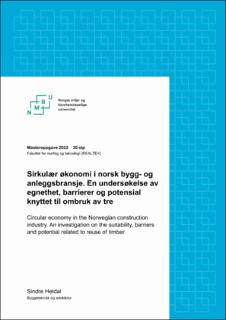| dc.contributor.advisor | Tsalkatidis, Themistoklis | |
| dc.contributor.author | Heldal, Sindre | |
| dc.coverage.spatial | Norway | en_US |
| dc.date.accessioned | 2022-08-17T07:50:49Z | |
| dc.date.available | 2022-08-17T07:50:49Z | |
| dc.date.issued | 2022 | |
| dc.identifier.uri | https://hdl.handle.net/11250/3012259 | |
| dc.description.abstract | Bygg- og anleggsbransjen er blant de store bidragsyterne til verdens stadig stigende klimagassutslipp og forbruk av naturressurser. Både nasjonalt og internasjonalt blir sirkulærøkonomiske tiltak trukket frem som virkemidler for å snu trenden. I en sirkulær økonomi vil ressursene sirkulere i kretsløpet lengst mulig, og dermed dempe etterspørselen etter naturressurser og redusere utslipp til produksjon av nye produkter.
Tre er et av verdens eldste bygningsmaterialer, og har en lang og innholdsrik historie for ombruk i Norge. I dag regnes graden av ombruk som ikke-tilstedeværende, til tross for at det i 2020 ble generert nærmere 270 000 tonn treavfall fra bygg- og anleggsbransjen alene. I oppgaven blir den sirkulærøkonomiske verdien til treavfall vurdert ved å se nærmere på hvor godt tre egner seg for ombruk, finne ut hvilke barrierer som hindrer ombruk av tre i dag og foreslå hva slags potensial for ombruk av tre som finnes. Oppgaven bruker litteratur til å undersøke om trevirkets egenskaper endrer seg som følge av tid og bruk, samt om praksiser og erfaringer fra land med tilsvarende forutsetninger kan være nyttige i norsk sammenheng. Det blir også utført intervjuer med representanter som har relevant erfaring og med forskjellige aktører i bransjen.
Funnene i oppgaven tyder på at trevirke i teorien egner seg for ombruk, men at ombruk i praksis vil være avhengig av formål. Mangelen på en standardisert form for evaluering av gjenværende egenskaper for brukt trevirke begrenser bruken i dag til estetiske eller andre ikke-bærende formål. Resultatene peker videre på fraværende opplæring innen sirkulærøkonomiske prinsipper og håndtering, regelverk som ikke legger til rette for ombruk og en ikke-eksisterende verdikjede som sentrale barrierer som hindrer ombruk i dag. Det fremstår som åpenbart at ombruk av tre kan skje i større grad, samtidig som en slik endring ikke vil skje av seg selv. Oppgaven foreslår et kompetanseløft innen sirkulærøkonomisk tankegang og byggeteknikk på videregående og akademisk nivå for å øke bevisstheten på tvers av bransjen. Et regelverk som tilrettelegger for og oppfordrer til ombruk i tillegg til økonomiske incentivordninger er tiltak som blir foreslått for å initiere en sirkulærøkonomisk verdikjede. | en_US |
| dc.description.abstract | The construction industry is among the major contributors to the world’s ever-increasing greenhouse gas emissions and consumption of natural resources. Circular economy measures are highlighted both nationally and internationally as instruments for reversing the trend. In a circular economy all resources will continue to circulate in the cycle for as long as possible, thereby curbing the demand for natural resources and reduce emissions related to the production of new products.
Timber is one of the world’s oldest construction materials and has a long and rich history of reuse in Norway. Today, the degree of reuse is close to non-present, even though in 2020 close to 270 000 000 kilograms of timber waste was generated by the construction industry alone. This thesis will assess the circular economic value of timber waste by studying how suited timber is for reuse, identifying which barriers that prevent reuse of timber today and suggesting the potential of reuse of timber that exists. The thesis includes literature that investigates if time and use will change the properties of timber, as well as if practices and experiences from countries with similar conditions can be useful in Norway. It also includes interviews with representatives who have relevant experience and with several actors across the industry.
The findings in this thesis indicate that timber is suitable for reuse, however application in practice will depend on the purpose. The lack of a standardized way of evaluating the remaining properties limits the use to aesthetic or non-load-bearing purposes. The results point to the absence of education in circular economic principles and handling, regulations that does not facilitate reuse and a non-existing value chain as the key barriers that prevent reuse today. It appears obvious that reuse of timber can take place to a greater extent, however the change will not happen by itself. The thesis suggests a competence boost in the circular economic mindset and construction techniques on upper secondary and academic level to increase the awareness across the industry. Regulations that facilitate and encourage reuse in addition to economic incentives are measures that are proposed to initiate a circular economic value chain. | en_US |
| dc.language.iso | nob | en_US |
| dc.publisher | Norwegian University of Life Sciences, Ås | en_US |
| dc.rights | Attribution-NonCommercial-NoDerivatives 4.0 Internasjonal | * |
| dc.rights.uri | http://creativecommons.org/licenses/by-nc-nd/4.0/deed.no | * |
| dc.title | Sirkulær økonomi i norsk bygg- og anleggsbransje : en undersøkelse av egnethet, barrierer og potensial knyttet til ombruk av tre | en_US |
| dc.title.alternative | Circular economy in the Norwegian construction industry : an investigation on the suitability, barriers and potential related to reuse of timber | en_US |
| dc.type | Master thesis | en_US |
| dc.description.localcode | M-BA | en_US |

